Soul Calibur II Preview
Check out even more info on Namco's upcoming arcade brawler.
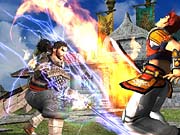
Soul Calibur II, simply put, is one of the most highly anticipated fighting games in recent memory. The original Soul Edge met with reasonable success in arcades and later on the PlayStation in an extras-laden home version. Soul Calibur was acclaimed in the arcades for its unprecedented degree of three-dimensional movement, but the Dreamcast version of the game was a phenomenon in itself. Breathtaking graphics that are still impressive to this day, an accessible but deep fighting system, and a wealth of extra modes and bonuses generated rave reviews from the gaming press and literally moved Dreamcast consoles off the shelves. For these reasons and more, Soul Calibur is universally considered to be among the very best of 3D console fighting games.
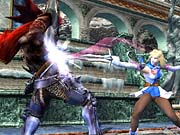
Soul Calibur II has been in development for more than a year, and information on the game has steadily leaked in quantities much too small to satiate the curiosity of fans. Each confirmed returning character made news, and three new characters have been added to an incomplete cast list. Screenshots and peeks at official material confirmed that at least small changes were being made to the gameplay, and the revelation that walls would be included in some form provided rumor reports for the media and generated limited discussion among die-hard fans. Until recently, anything and everything known about the finer details of the game was pure speculation.
Finally, the vaunted sequel was playable for the first time at the recent AOU 2002 Amusement Expo in Japan. Keep in mind, though, that all the information detailing the game's appearance at the show is based on an incomplete version of the game. Overall, the impression given was that the gameplay closely mirrored that of the original Soul Calibur. An identical button setup and familiar characters allowed players to utilize their proficiency with the first title in the sequel. The new playable characters seemed to be reincarnations of characters from the previous version of the game who won't be in the sequel. From an artistic standpoint, a noticeable increase in the animation quality was present, and the graphics themselves were roughly comparable to those of the Dreamcast port of Soul Calibur, albeit with a slight increase in the level of detail and fuller 3D backgrounds.
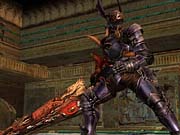
Peeling back the initial layer of familiarity, there are interesting facts to be discerned. Those intimately familiar with the original noticed the tweaks to individual moves that inevitably occur in a sequel, such as Taki being able to attack sooner after her "stalker" leap over the head of her opponent. Ivy Valentine can be seen wearing a small buckler on her wrist, using it to perform shield-smash moves that are similar to those of Sophitia or Lizard Man from Soul Calibur.
This first playable version of the game featured returning characters Mitsurugi, Astaroth, Nightmare, Taki, and Ivy, as well as new blood in the form of Yung Tsung and Cassandra. The character selection screen was modified to zoom in on the confirmed character, who would speak different prefight lines as players pushed one of the four buttons. For the most part, those who fought in the previous game were largely unchanged in physical appearance and fighting style, although it should be noted that there could be moves in the final version that were not included in the public demo. Walls were present in some stages, but at this point they had no real effect on gameplay.
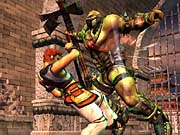
The two new playable characters in the build at the AOU Expo do bear a striking visual resemblance to those who came before them, but not without explanation. The newcomer Yung Tsung wields a sword that's similar to Hwang's and was trained at the same fighting school. Impressions from the show indicate that the new warrior incorporates more kicks into his fighting style than the character he replaces, and he has a variety of moves to send opponents into the air. Similar to Hwang, the new Korean warrior looks like he has a strong high-low game, good speed, and competent range.
Cassandra has taken up her older sister Sophitia's Omega Sword and Nemea shield and stepped onto the "stage of history," although she already seems to be substantially different from her sibling. While some of her available moves are similar, the younger daughter of the Alexandra family does not rely on the same key moves as Sophitia did. Cassandra is said to have slightly slower sword strokes but excellent response time, which allows her to dominate at mid-range.
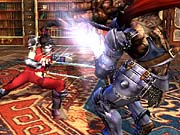
Changes to the basic game systems have been made as well, and some are noticeable right from the start. Three-dimensional movement has been made more easily accessible, now only requiring the player to hold the direction that want to move in and then run in any direction. The guard impact from the original Soul Calibur has also been simplified and given more versatility, while the guard parry seems to have been done away with entirely. Tapping forward and guard will repel high and mid-range blows, while back and guard will deflect moves in the lower range. A successful guard impact will parry the opponent's blade and allows the defender to gain the initiative. In Soul Calibur II, this technique has been made more responsive and hence easier to execute, and it can even be used during the eight-way run (this is especially valuable for slower characters). That the guard impact can be employed while moving in any direction is assumed to be possible due to a process known as motion blending.
Basically, motion blending is an existing technique that animates two parts of a character separately. The implementation of this system adds to the game from both an aesthetic and a gameplay standpoint. Producer Hiroyaki Yotoriyama gave the example of Ivy walking while spinning her whiplike sword, which, aside from giving her a menacing appearance, will allow her to perform a variety of attacks while keeping up her footwork. The transitions from movement to attack should appear much smoother as well, making the game more beautiful and more responsive.
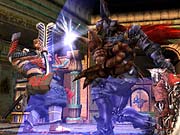
Considering how this can work to the advantage of other characters illustrates just how much of a bearing the blending of motion may have on gameplay. In the original Soul Calibur, characters like Mitsurugi used special stances like the "mist stance" that opened new attack options but severely limited their mobility. Motion blending will keep players who have taken a special stance from being "locked up." Nightmare, who continually shifted through three special stances while swinging his massive blade, is reported to have greatly increased mobility as a result.
All these individual elements--motion blending, enhanced 3D movement, and more effective guard impacts--are parts of a greater concept. This concept was stressed in Yotoriyama's interview with GameSpot--defining the relationship between the horizontal attack, vertical attack, and the eight-way run is one of the development team's major goals. While players could catch glimpses of this principle in the last game, the effect should be more palpable in the sequel.
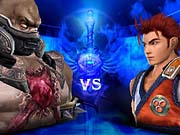
On a basic level, the system can be explained as follows: A vertical slash can be used to beat out a horizontal slash, the eight-way run can easily sidestep a vertical slash, and a horizontal slash can counter an eight-way run. This interplay is similar to that seen in Bushido Blade, but the system should not necessarily be interpreted as overly simple or rigid. The speed, range, angle, and priority of individual moves must be taken into account, and character speed, throws, kicks, and the guard impact also factor into the equation. Like any fighting game with substantial depth, it's impossible to pin down the exact balance of a game until long after its release.
After taking in everything that has been shown, it's important to consider how indicative these impressions are of the final product, as well as what has been kept hidden from view. In the aforementioned GameSpot interview, Yotoriyama said that the project is currently about 67 percent complete and the recent AOU demo was only 50 percent complete. This means the game shown was heavily rounded off for presentation. Characters officially confirmed by Namco so far are as follows: Xianghua, Kilik, Mitsurugi, Nightmare, Astaroth, Cassandra, Taki, Ivy, Yung Tsung, and Tarim. The only announced new character who was not playable, Tarim, is a 15-year-old wind priestess who wields two tonfa-like blades called "sajinkai" and practices a sword-dance style of martial arts. Judging from the screenshots, it appears that she will focus on double-blade strikes and acrobatic moves.
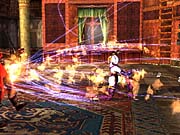
Only a few stages were available at the showing, and only the arcade, time attack, and versus modes were available from a selection screen that included two other empty slots (keep in mind that even more modes could be available for a home conversion). The producer mentioned that the game would probably include 70 percent returning characters and 30 percent new, which matches the current roster exactly. This suggests that other new characters could be revealed, along with more returning characters, or that this could be the final non-hidden/time-released character roster.
Aside from the obvious exclusions of characters, stages, and game modes, the walls that were present in certain arenas had no practical function as of yet. Additionally, ring outs were quite hard to come by. Namco addressed this briefly, stating that ring outs and walls would play a larger part in the final version of the game. Similar to an evasion roll after being knocked down, players will be able to spin to either side after impacting with a wall. Being slammed into a wall, however, will presumably cause extra damage. The spirit/soul charge, which allowed characters to power-up their attacks or even make certain moves unblockable, has not yet been revealed in its new capacity. Standard unblockable moves seem to be confirmed in screenshots, however, with rather impressive fireworks accompanying certain moves.
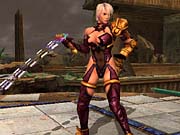
In the way of extras, Soul Calibur II's producer has stated that he would like to include as many extras in the arcade version as time allows. Those anticipating the same variety of modes and extras that Soul Calibur had on the Dreamcast for this newest console version can take heart in the dedication of the staff and the series' excellent track record. After all, even the original Soul Edge included a wealth of exclusive content.
Release dates have not been announced for any of the three console versions, but the arcade version is expected to be complete within the next few months, with console releases taking place within the year. Expect more details as they become available.
Got a news tip or want to contact us directly? Email news@gamespot.com
Join the conversation